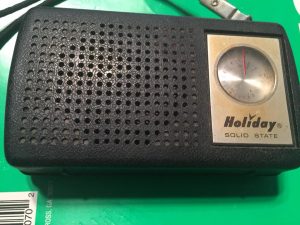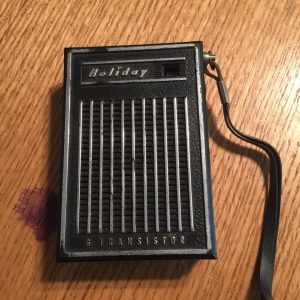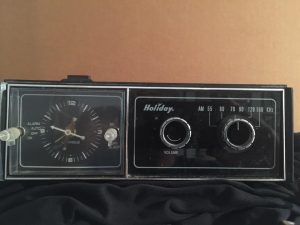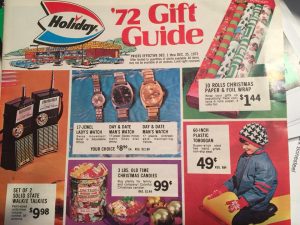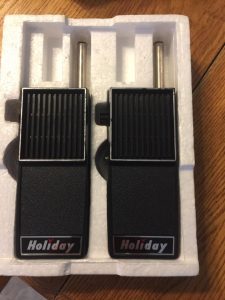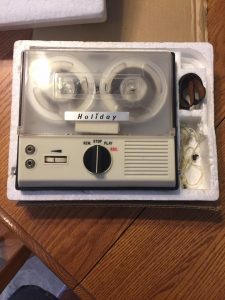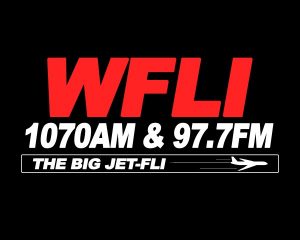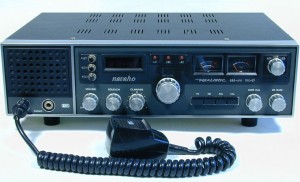 Not only did I spend a lot of time talking on the CB radio as a kid, I also spent a lot of time (and money) tape recording the antics of myself and others who happened to be on the channel. Whereas most normal people would have erased and/or discarded these cassettes years ago, I kept all of mine. I have at least 100 hours of CB conversations and probably more.
Not only did I spend a lot of time talking on the CB radio as a kid, I also spent a lot of time (and money) tape recording the antics of myself and others who happened to be on the channel. Whereas most normal people would have erased and/or discarded these cassettes years ago, I kept all of mine. I have at least 100 hours of CB conversations and probably more.
The “Kids’ Channel” in the southern suburbs of Minneapolis/St. Paul was Channel 14. This is where we hung out most of the time. Occasionally, a channel jammer or agitator would force us onto another frequency. Sometimes, *I* was the channel jammer/agitator in question. Many times, CB Channel 14 was complete chaos! But for the most part, it was good clean fun. It kept us home, instead of being out and getting into real trouble, as many other teenagers did.
From Drew’s Basement CB Archives, here are some real gems. If you think these tapes are the greatest thing you’ve ever heard, keep checking back. I’ll be adding more on this page as time allows. If you think these are crass, crude, and a complete waste of bandwidth, you’re in agreement with at least 95% of the civilized world!
Exhibit #1 – Drew vs Lissa. Lissa was a girl who liked me. But since I was a big 9th grader and she was only in 7th, I had no time for her. I also had this bad habit of harassing her on the CB. Especially when she was trying to talk to her boyfriend Brian, which was the case on this particular day in February, 1979.
I was using a Sears RoadTalker 40 AM/SSB base with a Hy-Gain Super Penetrator 500 at 66 feet above ground. Since I had a more powerful base station than Lissa did, I had no problem getting in between the young couple. This made the poor girl very angry, as you will hear.
Lissa, if you’re listening to this 31 years later, I’m sorry. Kids do stupid things sometimes!
CB_Drew_Vs_Lissa_February_1979
Exhibit #2 – The Dog Record. This is a great example of how CB agitators tend to multiply. Someone had either the record or tape of “Jingle Bells” by the Singing Dogs. They decided it would be a good idea to play this over the CB radio. So of course, another CB’er hears this, decides to record it, and then he plays it. Others do the same in a daisy-chain procession. Those who aren’t recording are trying to jam the ones who are playing music, as you will hear. Result? Pure anarchy! This was back when the FCC still required CB licenses and attempted to enforce the rules. Playing music was a big no-no! I’m surprised none of us ever got caught because of our antics. I was only 14 years old at the time, so I would have just claimed ignorance. This aired in April, 1980.
By this time, I no longer had my Sears RoadTalker 40 SSB. The reason was because I attempted one too many “power mods” and the radio went *poof!* So, I was back on my original radio which I always kept for a standby: a 23 channel Midland 13-882C mobile on a power supply. The Super Penetrator was lost to a windstorm the previous spring. (I was doing great, wasn’t I?) I replaced the Hy-Gain with an Antenna Specialists Starduster M400 at the same height, adding 10 feet of masting to offset the Starduster’s center feed and mounting point. Performance was about the same locally. The Starduster was definitely a better skip-talking antenna, though!
Doesn’t this make you want to go out, find, and strangle the guy who keeps playing that %$#@!! DOG RECORD??!!
Exhibit #3 – FROGGY! This guy was the original CB Rambo in the south Twin Cities metropolitan area. He would show up on Channel 14 suddenly and unpredictably. As soon as he did, the frequency would immediately descend into chaos. Using a healthy dose of profanities (the worst of which have been edited out of these clips), he was the Don Rickles of the CB radio: an equal opportunity insulter and antagonist.
The most famous Froggyisms were “take a dive!”, “ya little puny turd!”, “stoolface!”, and “ya dumb little bastard!” At one time, more than 60 CB’ers were out attempting to triangulate and locate this rebel without a cause. Over a 2 year period, there were countless attempts to find him and learn his identity. No one ever did. 42 years later, I still have no idea who Froggy was. It was the ultimate unsolved mystery of CB Channel 14 in Minneapolis/St. Paul.
Though Froggy’s identity was never learned, it was a pretty good guess he was either an electronics engineer or technician of some sort. His signal was always strong and his audio was extremely clean. He claimed to run 1,000 watts in his car. Doesn’t sound like much by today’s standards, but this was a HUGE amount of power in 1977. This would explain why nobody could find him despite having an S9+ meter reading on his signal. Very likely, Froggy was transmitting from a remote location and the hunters weren’t even close. His technical expertise would explain why the audio was so clean at such a high wattage. Also, it was assumed he altered his voice electronically to create the “frog in the throat” effect. There were times when he would transmit for an hour or two. If he tried to do the “Froggy voice” manually, his throat would be sore after several minutes. The voice was always consistent. Finally, the guy knows his equipment, as you will hear in these recordings. I’ve always guessed that Froggy was either an engineer for one of the local radio/TV stations or a commercial radio technician. Messing around on the CB with big power was what he did in his spare time. Of course, the world will never know for sure.
The following 3 audio clips were recorded on Friday, November 25, 1977 from my residence in Apple Valley, MN. At that time, my base station consisted of a 40 channel AM Midland 77-882 mobile radio, Micronta 2.5 amp power supply, and a HyGain Super Penetrator 500 omnidirectional base antenna which reached 66 feet above ground level. Mounted on 20′ of masting atop our 2 story house, that Penetrator was my pride and joy. WARNING: Some of Froggy’s language is not suitable for kids!
Froggy vs Goldilocks, MN Gopher, El Lobo, and Cave Bear: CB_Froggy_November_25_1977_Part_1
Froggy vs Minnesota Gopher: CB_Froggy_November_25_1977_Part_2
Froggy vs KW Kid: CB_Froggy_November_25_1977_Part_3
Exhibit #4: More CB “tough talk” with Scorpion vs Rob. This is your typical CB argument: two teenage guys fighting over a girl. The first one makes threats, the second says “come on over and do it!” I didn’t know these guys personally. They were from Bloomington (about 10 miles north of me) and hung out on Channel 11. I just happened to be scanning the channels, caught the argument, and turned on my recorder. By this time, I had become sophisticated enough to patch the CB audio directly into my stereo system and use TDK tape instead of the cheap “bag” cassettes. There’s nothing better than a CB argument in high fidelity! This aired during the summer of 1983:
Exhibit #5 – KADF-6895 Rhinestone Cowboy and KAUX-9819 Gumball – Here I am, playing to the tape recorder. My CB buddy Gumball is recording on this day, so I can hear what I sound like over the air. “Everybody be quiet for 5 seconds, I wish to enjoy my power. Starting now!” From August, 1977:
CB_Rhinestone_Cowboy_Gumball_August_1977
Exhibit #6 – Mark vs _______’s Lawn! – This guy didn’t have a handle, he just went by “Mark.” He lived near Burnsville Parkway (then Burnsville Crosstown) and I-35W. Drove a gold 1972 Buick Skylark 350. On this day, however, he was piloting his dad’s 1976 Buick Electra 455. Mark decides to test the horsepower and torque of his father’s car by doing a LAWN DEED, broadcast live on CB Channel 14! For those not familiar with these nasty pranks, a lawn deed is when you purposely drive your car over someone’s lawn, spinning the tires in order to cause maximum damage to the grass. I won’t divulge the lucky recipient of this lawn deed. Has the statute of limitations expired yet? From the spring of 1981:
Exhibit #7 – KABZ-1645 Scooter Rabbit vs Unidentified Enemy – In September, 1976, Scooter Rabbit had one of the stronger base stations in Apple Valley. He lived on the hill, near the old water tower. Scooter was 17 at the time, so he usually operated on Channel 14. Occasionally, however, he would go down to Channel 4 which was “the adults’ channel.” Several Lakeville CB’ers in their 30s and 40s frequented Channel 4. Whenever Scooter Rabbit showed up there, an argument immediately ensued.
CB_Scooter_Rabbit_September_1976
Exhibit #8 – KLW-6032 Half Breed & Her Friends – Half Breed lived in Prior Lake. Because of the distance between us, I couldn’t hear her very well. But I liked her, so I always tried to pick her out of the noise and engage her in conversation. Also heard here are fellow Prior Lake CB’ers Mud Puppy and Little Bugger. Along with KAIS-2978 Cockroach from Apple Valley and KZA-0039 Goldilocks in Lakeville. A typical day on the CB in December, 1977:
Exhibit #9 – KAUX-9819 Gumball, KWE-9270 Cannonball, KAJB-5272 Space Trucker, and KGU-3859 Minnesota Gopher. August, 1977.
CB_Gumball_Cannonball_SpaceTrucker_MN_Gopher_August_1977
Exhibit #10 – KAUX-9819 Gumball, KABI-2511 Disco Kid, KWE-9270 Cannonball, KWE-9270 Little Fry, KAJB-5272 Space Trucker, and KADF-6895 Rhinestone Cowboy. August, 1977.
CB_Gumball_Disco_Kid_Cannonball_Little_Fry_Rhinestone_Cowboy_August_1977
Exhibit #11 – Dave’s Phone Prank – Another guy with no handle was “Dave” from West Bloomington. Here, he’s attempting a crank phone call on live CB radio. But he has a bit of a problem getting everything to work properly between the telephone and his base station microphone. This aired in the summer of 1982:
CB_Dave_Kraft_Phone_Prank_1982
Exhibit #12 – KKH-5848 Cotton Picker, KAUX-9819 Crispy Critter, and Sugar Cookie. August, 1977.
CB_Crispy_Critter_Cotton_Picker_Sugar_Cookie_August_1977
Exhibit #13 – KABY-3339 KW Kid, KADF-6895 Rhinestone Cowboy, and Minnesota Sweetheart. KW Kid loved to play his guitar over the CB radio. Since he wasn’t able to afford a locking desk microphone, he custom-designed a wine bottle by cutting off the top. This allowed him to place the CB hand mic in the bottle and keep it keyed while he played. It actually worked very well, as you will hear in this clip from June, 1978:
CB_KW_Rhinestone_Cowboy_Sweetheart_June_28_1978
Exhibit #14 – A second clip from June 28, 1978. Here, we are joined by KLW-4092 Winchester and an unidentified young kid who keeps dropping perverted comments into the conversation!
CB_KW_MN_Sweetheart_Winchester_June_28_1978
Exhibit #15 – KZA-0039 Goldilocks and KAHO-1877 Grey Fox vs FESTER! – Froggy (see above) had a “cousin!” At first, we thought it was the same ‘ol agitator. Then, we listened carefully and realized the voice was slightly different. We called him ‘Fester.’ An imitator, but a good one. This aired in January, 1978:
CB_Goldie_vs_Fester_January_18_1978
Exhibit #16 – Black Max Plays His Jaw Harp – Black Max aka “Bob in Bloomington” was a pretty proficient jaw harp player. He played it often on CB Channel 14, along with his electronic organ. In this clip from the summer of 1982, he performs “You are a Randy”, a cyborg-like slam against one of his CB enemies.
Exhibit #17 – KABA-6010 Kid Flash and KADF-6895 Rhinestone Cowboy meet “Jesus” – This is my earliest and first CB tape. I recorded it in September, 1976, just a few weeks after getting my first CB radio. As my friend Kid Flash signs off, an unidentified guy who calls himself “Jesus” appears. I was 12 and as you can hear, this was recorded before my voice changed!
CB_Kid_Flash_Rhinestone_Jesus_September_1976
There are a lot of missing Minnesota CBers who should be represented here! If you have suggestions for additions, please let us know. Better yet, if you are lucky enough to have surviving Minnesota CB radio tapes from the 1970s and/or 1980s, contact us via e-mail or leave comments below. And that’s a big 10-4!

